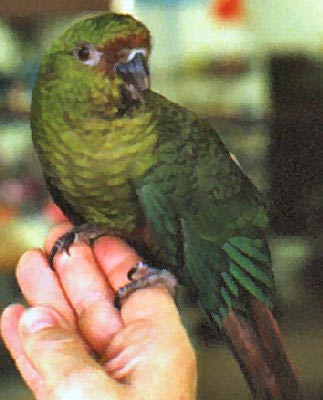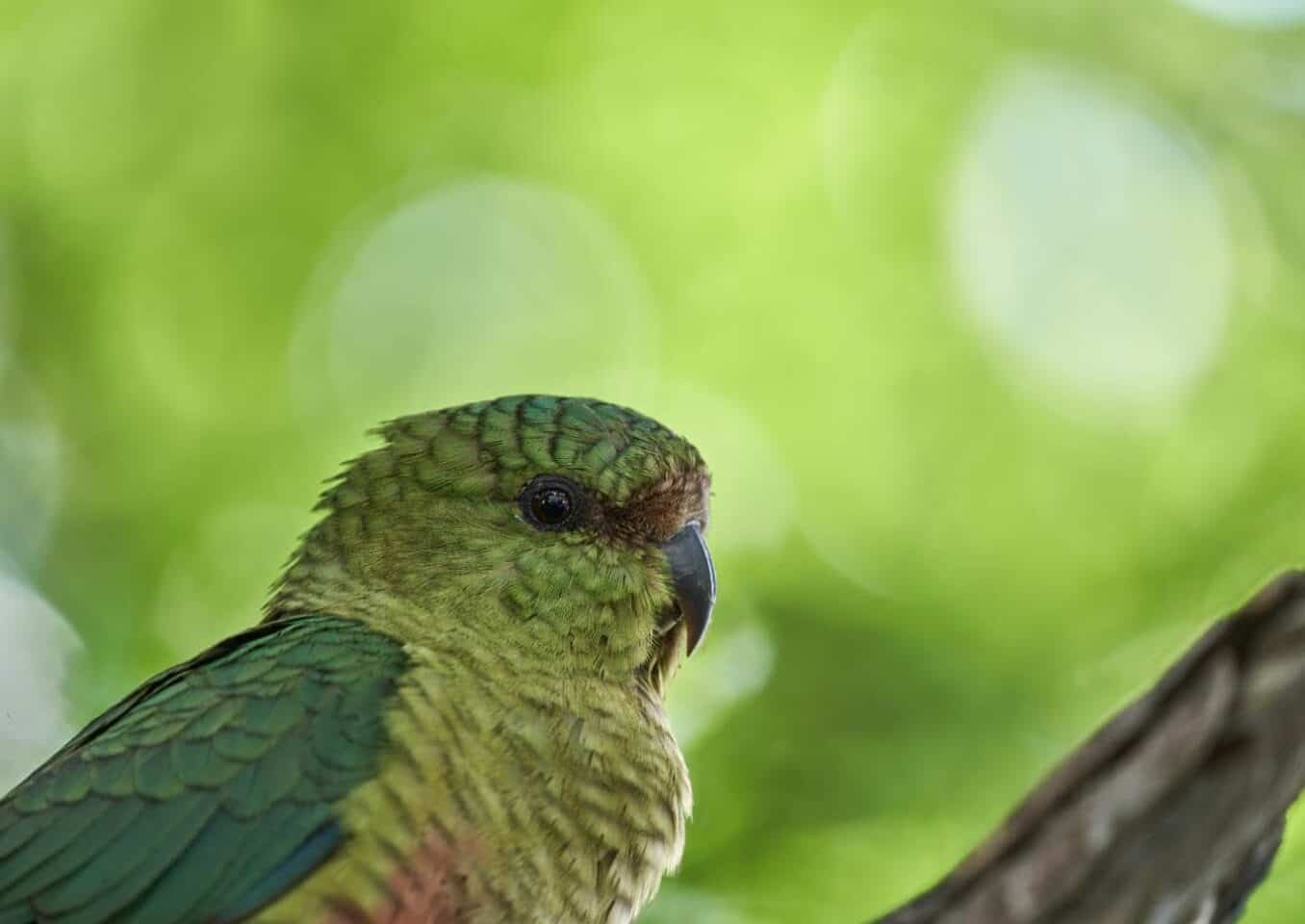“Aussie” is an Austral Conure that is about 5 months old. Aussie was handfed and likes the company of people very much. He is very quiet and sweet tempered, and enjoys being held.

The Austral Conure is favored as an excellent aviary bird as they are not obnoxious or overly noisy. They also make a sweet and loveable companion, with a quiet easy going disposition. They enjoy evening activity which makes them ideal for people who are home to interact with a pet later in the day.
This conure is not as well known as many other conures, even its smaller cousin the Chilean Conure is more well known. This is probably because it was first bred in captivity in the East Berlin Zoo in the early 1970’s. But more and more are being bred in captivity in the United States, and we should see them become more readily available.
For more information about the care of Conures see:
Guide to a Happy, Healthy Conure
- Kingdom: Animalia
- Phylum: Chordata
- Class: Aves
- Order: Psittaciformes
- Family: Psittacidae
- Genus: Enicognathus
- Species: ferrugineus ferrugineus
Scientific Name:
Enicognathus ferrugineus ferrugineus
Subspecies:
- Austral Conure/ Magellan Conure
Enicognathus ferrugineus ferrugineus - Chilean Conure
Enicognathus ferrugineus minor
The Chilean Conure E. ferrugineus minor, is also from southwestern Argentina and Chili, though is generally found farther north.
It is better known and a more readily available conure than the Austral Conure. It is a bit smaller than the Austral Conure, being 13 1/5″ (34 cm), and is somewhat darker. It also has a darker head band and the belly patch often times disappears in the darker birds. The Chilean Conure also lays smaller clutches of eggs than its larger cousin.
Distribution:
They originate from southern South America in lower Argentina and Chile. The Austral Conure is one of only two species in the Ericognatus genus. Along with the Slender-billed Conure Enicognathus leptorhynchus they are the most southerly distributed of all parrots.
Description:
Also known as the Magellan Conure, the Austral Conure belongs to the parrot family. The plumage is mainly green with darkly edged feathers giving it a barred appearance. They have a forehead and eye stripe that are a dull reddish brown and the crown is slightly tinged with blue, There is a reddish brown patch on the belly and the outer wings are green tinged with blue along the edge.The tail is brownish red tipped with green. The beak is brown/black and the iris is reddish brown. On juveniles, the red markings on the forehead and the abdomen are duller and less extensive.
Size – Weight:
A mature Austral Conure is about 13 3/4 ” (37 cm) long and weighs 4.9 ounces (139 g). The slightly smaller Chilean Conure is about 13 1/3″ (34 cm).
Care and feeding:
A roomy cage is required unless the bird is to be let out for extended periods. Many birds can spend most of their time on a play pen or parrot perch. A night shelter is recommended for this conure and will be greatly appreciated. A good sleeping box size is 24″ x 19 1/2″ x 17 34″ (60x50x45 cm). The Austral Conure is also sensitive to drafts and drops in temperature.
In the wild Austral Conures eat seed, fruits, berries, leaf buds, bulbous roots, grass seed, and acorns. They are seen in farmer’s fields when the crops are ripening and have been know to cause considerable damage to farmlands from their feeding on the ripened grains.
The Austral’s main diet should primarily be seeds, fruits, and vegetables. A commercially prepared avian pelleted diet can also be beneficial. Because they like to forage seed on the ground, sprinkling additional seed on the cage bottom or the aviary floor is pleasing to them.
See About Conures: Housing and About Conures: Care and Feeding for more information.
Social Behaviors:
Wild conures are friendly and peaceful. They live together in groups of 20 or more birds and seldom fight with each other. The Austral Conure is no exception and can be seen in flocks from as few as 10 birds to flocks of over 100 birds.
Breeding/Reproduction:
In their natural environment, the Austral Conure nests in a tree hollow. The female lays quite a large clutch of four to seven eggs which are incubated for 21 to 27 days. The young leave the nest at six to eight weeks.
The Chilean Conure has a smaller clutch and will lay between two to six eggs.
Potential Problems:
This bird is not nearly as noisy as many of the conures. They are sensitive to, and could get ill from drafts and a drop in temperature.
See About Conures: Potential Problems for information on illnesses.
Availability:
The Austral Conure is occasionally available, but not nearly as available as its better known cousin the Chilean Conure. Your best bet is to find one at a pet store or a reputable breeder.
Activities:
Loves to climb and play. Provide lots of toys.
Featured Image Credit: Jens Otte, Shutterstock
